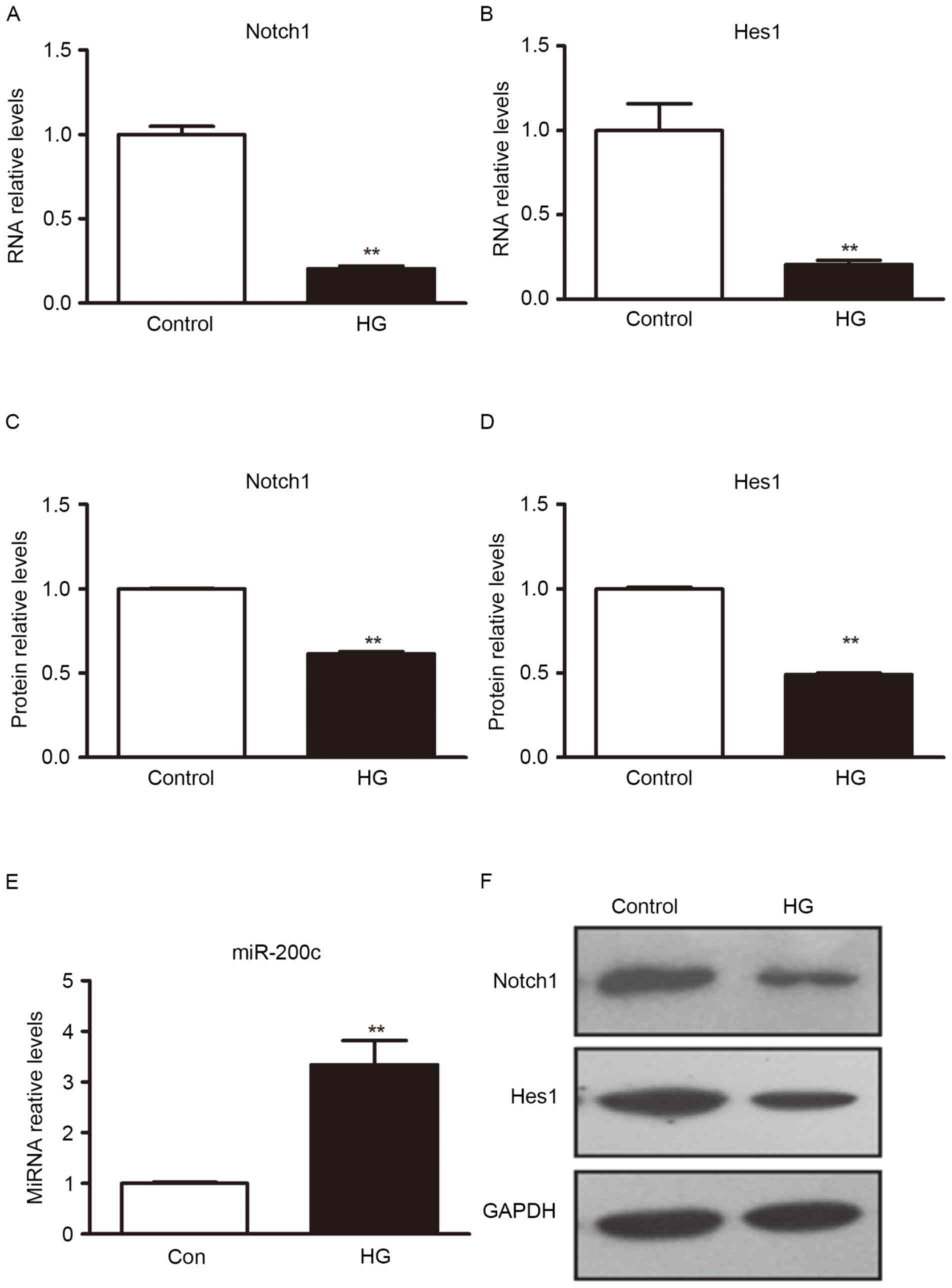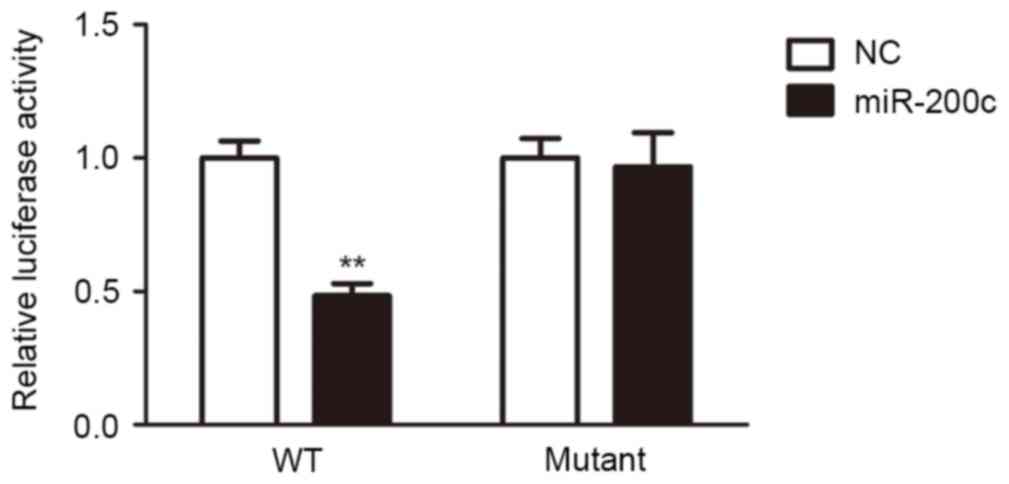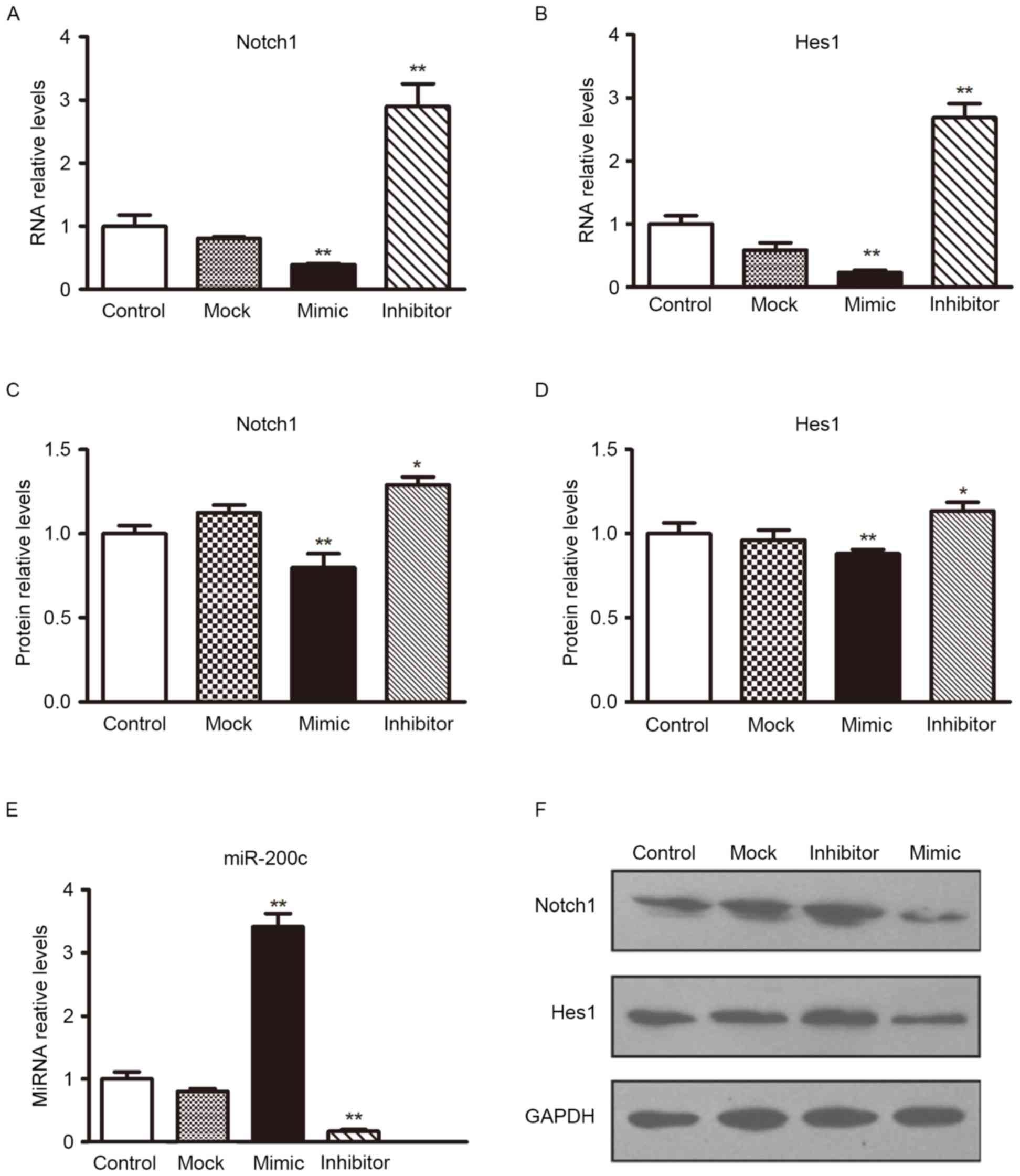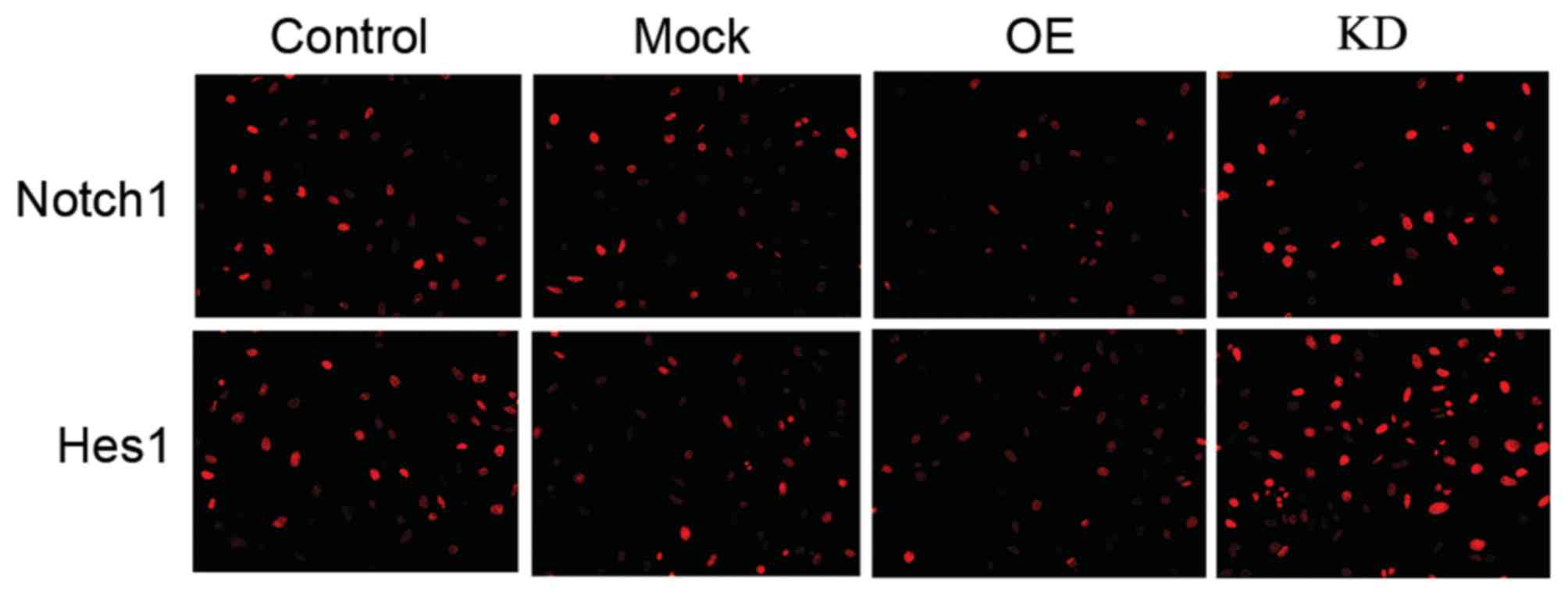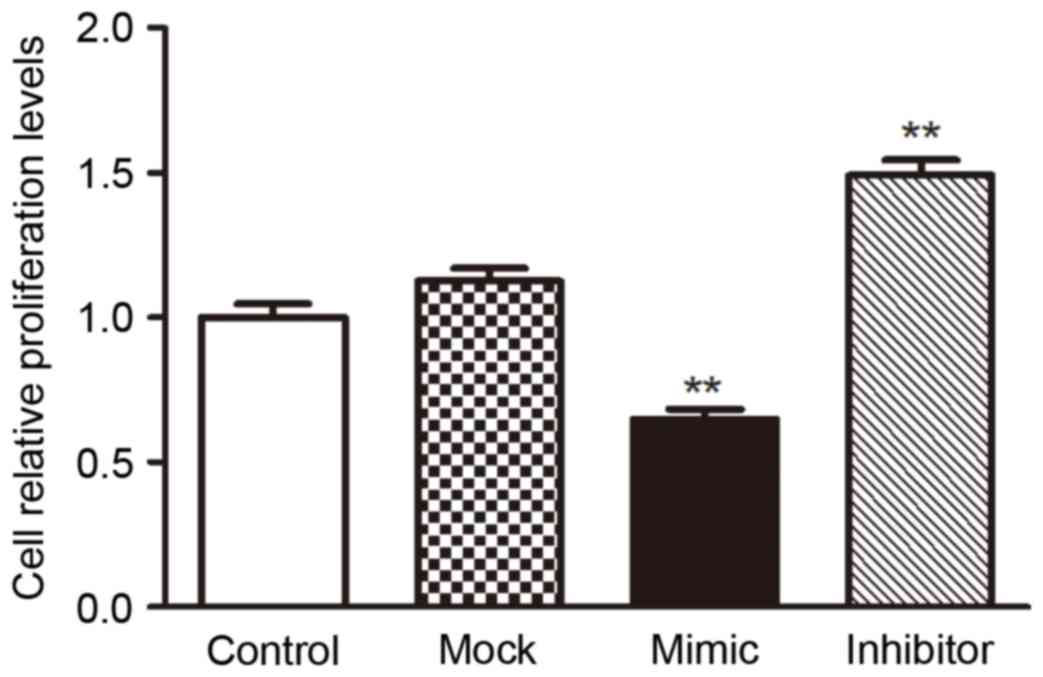miR-200c serves an important role in H5V endothelial cells in high glucose by targeting Notch1
- Authors:
- Published online on: June 15, 2017 https://doi.org/10.3892/mmr.2017.6792
- Pages: 2149-2155
Abstract
Introduction
Microvascular related diseases are the most frequent complications of diabetes (1); especially diabetic foot, which afflicts ~10% of people with diabetes (2). The vascular endothelium is considered to serve an essential role in diabetes-associated microvascular dysfunction, especially diabetic foot. The endothelium serve a significant role in the regulation of microvascular function and development of physiological and pathophysiological inflammation. Endothelial cell (EC) injury is a critical element of diabetic foot (2). Previous studies have reported that high blood glucose induces EC apoptosis, and causes cellular dysfunction and cell death (1). However, the vascular function pathogenesis is complicated and there are a number of signaling pathways involved, including the Notch pathway.
The Notch1 signaling pathway is significant in cell differentiation, primarily determining and regulating cell survival (3). In mammals, four receptors (Notch1-Notch4) and five ligands, Jagged1, Jagged2, Delta-like (Dl)1, Dll3 and Dll4, have been discovered (4,5). Dysregulation or loss of Notch signaling underlies a wide range of human disorders (6). A previous study indicates that Notch signals inhibit the development of erythroid/megakaryocytic cells by suppressing GATA-1 activity through the induction of Hes1 (7), Mutations in Notch1 cause aortic valve disease (8).
The Notch/Hes1 pathway has been identified to play a key role in mediating ECs function (8,9), participating in regulating angiogenesis, development and vascular inflammation reaction related pathophysiology process. DLL4-Notch signaling has a key role in regulation of tumor angiogenesis (4,10), and serve an important role in placental angiogenesis (11). Previous studies demonstrated that vaccarin attenuates the human EA.hy926 ECs oxidative stress injury through inhibition of Notch signaling (12). Another report indicated that Dll4 signaling through Notch1 regulates formation of tip cells during angiogenesis (4).
Hyperglycemia can cause inflammation and oxidative stress, leading to EC damage. It has also been demonstrated to mediate NF-κB activation, increase Nox4 expression, and increase inflammatory cytokine activation in vascular smooth muscle (13,14). Furthermore, hyperglycemia also causes the Notch signal pathway to be aberrantly activated (15).
MicroRNAs (miRNAs) are endogenous conservative noncoding small RNAs of 21–25 nucleotides and through binding to 3′-untranslated regions (3′UTRs) of the target mRNA (16), usually resulting in translational repression or target mRNA degradation and gene silencing. miRNAs regulate many cellular biological activities ranging from cell growth and differentiation, apoptosis, metabolism and angiogenesis. Studies demonstrated that hyperglycemia may cause abnormal high expression of clusters of miRNAs affecting a series of pathophysiology process (17). In addition, series of miRNAs serve an important role in the hyperglycemia-related pathophysiology process (18).
miR-200c is upregulated by oxidative stress and induces EC apoptosis and senescence via zinc finger E-box-binding homeobox (ZEB)1 inhibition (19). miR-200c may regulate vascular endothelial growth factor A, ZEBs, fms related tyrosine kinase 1, I kappa B kinase β, Krüppel-like factor 9, fibulin-5 (8) or ZEB1 (20) to participate in regulating EC function. The present study predicted that miR-200c and Notch1 had complementary pairing in promoter regions by using the computer software TargetScan version 7.1. Hyperglycemia-induced vascular lesions are the leading cause of diabetic lower limb ischemia. Previous studies have identified that miR-200c was significantly increased expression in the serum of type 2 diabetes patients with critical limb ischemia, which may suggest that miR-200c is possibly related to regulating mechanism of diabetic vascular endothelial injury. However, how miR-200c is involved in the diabetic vascular injury has never been reported.
The miR-200 family includes miR-200a, miR-200b, miR-200c, miR-429 and miR-141; they have emerged as noticeable markers for predicting cancer prognosis and tumors progression. miR-200c is a tumor suppressor in various cancers, such as pancreatic, gastric and breast cancer through the inhibition of Kirsten rat sarcoma viral oncogene homolog (KRAS) (21,22), and the mediation of Leydig tumor cells and murine adrenocortical tumor cells by vimentin. Another study using luciferase reporter plasmids observed that miR-200c inhibited the AKT and ERK pathways by directly targeting KRAS. It is suggested that miR-200c may be related to normal cells survival and function, rather than malignant cells. A previous study indicated that miR-200c served an important role in EC differentiation and vasculogenesis by targeting the transcription repressor ZEB1 (18).
The purpose of the present study was to investigate how high glucose mediated miR-200c and Notch1, and whether miR-200c can regulate EC differentiation and function via the Notch1/Hes1 signal pathway in vitro, in addition to the role of miR-200c in H5V apoptosis under high glucose conditions.
Materials and methods
Cell lines and cell culture
H5V cells, which are murine heart endothelial immortalized cells (23) (kindly provided by Nanjing Medical University (Nanjing, China), were cultured in Dulbecco's modified Eagle's medium (DMEM, Gibco, USA) containing fetal calf serum 10% (v/v), 100 U/ml penicillin and 100 µg/ml streptomycin, in a humidified incubator at 37°C with 5% CO2.
miRNA overexpression
An miRNA mimic (a synthetic RNA oligonucleotide duplex mimicking miRNA precursor) purchased from Suzhou GenePharma Co., Ltd, (Suzhou, China) was used for overexpression of miRNA. The synthetic RNA molecules were purchased from Shanghai GenePharma Co., Ltd. (Shanghai, China) including pre-miR-200c and pre-miR-control (scrambled negative control RNA). H5V cells were seeded in six-well plates (2×105) in complete medium without antibiotics at least 24 h prior to transfection, when cell confluence was ~70%, a final concentration of 50 nM miRNA-200c-mimics, miRNA-200c-inhibitor and NC RNA were transfected into the cells using Lipofectamine 2000 (Invitrogen; Thermo Fisher Scientific, Inc., Waltham, MA, USA) according to the manufacturer's instructions. A total of 6 h later, the culture medium was replaced with DMEM supplemented with 2% fetal bovine serum, the cells continued to be cultured for 24 or 48 h; they were then harvested and processed for further analysis.
Western blot analysis
H5V cells were lysed in RIPA lysis buffer (Beyotime Institute of Biotechnology, Shanghai, China), total protein was separated by 10% SDS-PAGE and blotted onto polyvinylidene difluoride membranes. The membrane was blocked with 5% skimmed milk and incubated with primary antibodies (anti-Notch1; ab52627; 1:2,000; anti-Hes1; ab108937; 1:1,000, anti-GAPDH; ab181602; 1:5,000; all from Abcam, Cambridge, MA, USA) overnight at 4°C. It was then incubated with horseradish peroxidase-conjugated anti-rabbit or anti mouse secondary immunoglobulins (B0014K052600; 1:2,000; BioSharp, Anhui, China) for 2 h at room temperature. The signal was then detected by enhanced chemiluminescence (Pierce; Thermo Fisher Scientific, Inc.), according to the manufacturer's protocol. The data were quantified by ImageJ version 1.43 (National Institutes of Health, Bethesda, MD, USA).
Reverse transcription-quantitative polymerase chain reaction (RT-qPCR)
Total RNA was extracted with the TRIzol reagent (Invitrogen; Thermo Fisher Scientific, Inc.) according to the manufacturer's protocol. cDNA was reverse transcribed using RevertAid First Strand cDNA Synthesis Kit (Invitrogen; Thermo Fisher Scientific, Inc.). Briefly, cDNA was synthesized using a miR-200c specific primer (Sangon Biotech Co., Ltd., Shanghai, China) in a reverse transcription system. The reaction conditions were as follows: 16°C for 30 min, 42°C for 42 min, 85°C for 5 min. Quantitative detection of reverse transcription products was performed using specific sense and antisense primers of miR-200c and SYBR Green I dye (Molecular Probes; Thermo Fisher Scientific, Inc.). The PCR reaction condition was as follows: 95°C for 5 min, 94°C for 20 sec, 55°C for 20 sec, and 72°C for 20 sec, for 40 cycles, to obtain fluorescence intensity. U6 was used as an internal control. The sequence of specific primer for miR-200c was: 5′-GTCGTATCCAGTGCGTGTCGTGGAGTCGGCAATGCACTGGATACGACTCCATC-3′; miR-200c sense primer, 5′-TAATACTGCCGGGTAAT-3′; miR-200c antisense primer, 5′-GTGCAGGGTCCGAGGT-3′. The Cq value was analyzed using the RFQ-PCR 7500 (Applied Biosystems; Thermo Fisher Scientific, Inc.) analysis program version 2.0.6). Relative mRNA expression levels were determined by the 2−ΔΔCq method (24) in comparison with control cells.
Cell survival assay
The cell suspension was inoculated in 96-well plates (100 µl/well). The culture plate was maintained in the incubator (37°C and 5% CO2). A total of 10 µl CCK (Shanghai Qcbio Science & Technologies Co., Ltd., Shanghai, China) was added to each well, and the culture plate was incubated in incubator for 1–4 h. Absorbance was measured at 450 nm with a microplate reader (BioTex, Houston, TX, USA).
Immunofluorescence staining for Notch1 and Hes1
Cells were fixed with PBS containing 4% paraformaldehyde (Sigma-Aldrich; Merck KGaA) for 20 min, permeabilized and blocked with blocking buffer (Abcam) for 30 min. Cells were then incubated with rat anti-mouse Notch1 primary antibody (ab52627; 1:2,000; Abcam) at 4°C overnight, followed by incubation with Alexa fluoro 555 conjugated secondary antibodies (A32727; 1:1,000; Invitrogen; Thermo Fisher Scientific, Inc.) at 37°C for 30 min. Nuclei were stained with DAPI (Sigma-Aldrich; Merck KGaA). Images were acquired using a 50i Nikon fluorescence microscope (Nikon Corporation, Tokyo, Japan). Images were processed with Adobe Photoshop CS4 software version 11.0 (Adobe Systems, Inc., San Jose, CA, USA). The proliferation rate referred to the number of Notch/Hes1-positive cells divided by the number of DAPI-stained cells.
Luciferase reporter assay
Using NCBI GeneBank database (https://www.ncbi.nlm.nih.gov/gene/), the authors synthesized 3′ untranslated region (3′-UTR) sequences of target genes at 100–120 nt in length containing the seed sequence. The full-length of 3′-UTR of the Notch1 gene was amplified by PCR from H5V genomic DNA and inserted into pGL3 control vector (Promega Corporation, Madison, WI, USA). Using the Qiagen XL-site directed Mutagenesis Kit (Qiagen, Valencia, CA, USA), the authors constructed several inserts by deletions of 4 bp from the complementarity site of the Notch1 gene. Lipofectamine 2000 was used to transfect H5V cells when cell confluence reached 80% in a 24-well plate with a 0.5 µg firefly luciferase reporter vector (Sangon Biotech Co., Ltd.) and 0.5 µg control vector containing Renilla luciferase (Sangon Biotech Co., Ltd.), phRL-TK (Promega Corporation) by Amaxa Nucleofector (Lonza Group, Basel, Switzerland). Each Nucleofector used 50 nM of the miR-200c or a scrambled oligonucleotide. At 48 h, the relative luciferase activities of Firefly/Renilla were consecutively measured through the dual luciferase assay (Promega Corporation). All data are presented as mean ± standard deviation.
Statistical analysis
All experiments were performed at least three times. Comparisons between two observations were analyzed by Student's paired t-test, and multiple comparisons with a one- or two-way analysis of variance. Multiple testing bias was assessed with the Bonferroni test. Data are expressed as mean ± standard error of the mean. P<0.05 was considered to indicate a statistically significant difference.
Results
High glucose induced miR-200c expression
Exposing ECs to high glucose is thought to mimic the hyperglycemia of diabetic patients. miR-200c is upregulated by oxidative stress and induces EC apoptosis and senescence via Notch1 inhibition (19), hyperglycemia is the principal cause of induced oxidative stress (13). To investigate whether high glucose was able to induce expression of miR-200c in H5V cells, the H5V cells were cultured in different glucose concentration for comparison. Cells were cultured under normal glucose (5 mM) or high glucose (25 mM). Taking normal glucose as a control, the H5V cells were cultured for 8 h and miRNAs expression level was determined through RT-qPCR. When compared with cells in normal culture medium, miR-200c was upregulated under high glucose conditions (Fig. 1).
Notch1 and Hes1 gene was repressed by high glucose
The Notch1/Hes1 signal pathway serves an important role in EC development and its function (6,8). To determine how hyperglycemic stress affects Notch1 and Hes1, H5V cells were exposed to high glucose conditions, with normal culture medium as the control. Western blot analysis was used to detect Notch1 and Hes1 protein expression. RT-qPCR was used to detect Notch1 and Hes1 mRNA expression. The result indicated that, under the condition of high sugar medium, Notch1 and Hes1 protein and mRNA level expression were significantly decreased, compared with normal culture medium (P<0.01; Fig. 1).
miR-200c inhibited the Notch1/Hes pathway by targeting Notch1
To explore the function of miR-200c, computational algorithms (TargetScan and miRanda) were used to identify the potential target gene of miR-200c. It demonstrated that Notch1 was a target gene of miR-200c (Table I). Luciferase reporter assays were performed to clarify this finding. The full-length Notch1 was cloned downstream of the firefly luciferase gene and co-transfected with miR-200c mimics or scrambled oligonucleotides controls. Luciferase activity was measured 48 h following transfection. Luciferase expression was decreased in H5V cells that were co-transfected with miR-200c and the wild-type Notch 3′-UTR, compared to the control. However, no decrease can be observed in cells co-transfected with miR-200c and the mutant Notch1 3′-UTR in comparison with controls (Fig. 2). These results suggested that miR-200c can directly target Notch1.
To determine the level at which miR-200c influences Notch1 expression, the expression of Notch1 mRNA was analyzed following transfection with miR-200c mimics or scramble oligonucleotides controls in H5V cells. Following transfection with miR-200c mimics, transfection efficiency could be observed in Fig. 3E; the expression of Notch1/Hes1 mRNA in the H5V cell line was lower than in the controls (Figs. 3A and B). The effect of miR-200c on Notch1/Hes1 expression was also verified by western blotting analyses (Figs. 3C, D and F). The overexpression of miR-200c reduced Notch1/Hes1 protein levels significantly. These results provide evidence that miR-200c directly recognizes the 3′-UTR of Notch 1 mRNA and inhibits Notch 1 translation.
Although Notch 1 serves a wide-ranging role in controlling cell fate, differentiation and development (25), in ECs, the activation of Notch1 can trigger the Notch1/Hes1 signal pathway (7), which serves an important role in ECs' development and function. Therefore, it was presumed that miR-200c may regulate that pathway by targeting Notch1. Therefore, the authors upregulated miR-200c levels via miR-200c mimics in H5V cells. As verified by similar results from protein quantification and an immunocytochemistry assay (Fig. 4), the western blotting results demonstrated that miR-200c decreased the expression levels of Notch 1 and Hes1 (Figs. 5C, D and F).
Subsequently, H5V cells were treated with miR-200c or a scramble control. At 24 h, they were transfected with Notch1-encoding vector (without an endogenous 3′-UTR) or mock vector (Fig. 3E presented that the transfection was successful in H5V cells). The miR-200c mimic inhibited the expression of Notch1, a similar alteration was observed in the expression levels of Hes1. However, the expression level of Notch1 and Hes1 was increased by enhancing miR-200c inhibition in H5V cells (Fig. 3). These results suggested that miR-200c inhibits the Notch1 and Hes1 pathway by targeting Notch1.
miR-200c inhibited the proliferation of VEC H5V by targeting Notch1
To investigate the biological consequences of the miR-200c-driven repression of Notch1 in H5V cells, the authors investigated whether increasing or decreasing the expression of miR-200c would have an impact on cell proliferation in H5V cells. H5V cells were transfected with miR-200c mimics, miR-200c inhibitors or their scrambled oligonucleotides controls, respectively, then were counted after 24 h by CCK8 assay. The result showed that the increased expression of miR-200c in H5V cells inhibited the cell proliferation compared with the control cells, while the decreased expression of miR-200c promoted the proliferation (Fig. 5).
The above results prompted us to validate that miR-200c could inhibit the proliferation of H5V cell by repressing Notch1 expression, it was involved in the development of vasculopathy induced by hyperglycemia. For this purpose, H5V cells were transfected with mock vector, scrambled oligonucleotides controls, Notch1-encoding vector + miR-200c or mock vector + scrambled oligonucleotides controls, respectively. The results indicated that increased expression of miR-200c inhibited proliferation by repressing Notch1 in high glucose condition (Fig. 5).
Discussion
Exposure of the vascular endothelial tissue to high blood sugar causes vascular lesions of diabetic lower limbs, thereby causing ischemia, which serves a critical role in the pathogenesis of diabetic vascular complications. Previous studies indicated that high blood sugar dysregulated multiple miRNAs, including miR-200c (1,17,18), which results in cellular dysfunction, cell apoptosis and cell death through targeting their downstream proteins. Notch signaling has been widely connected in epithelial-mesenchymal transition, EC proliferation and apoptosis regulation (15), it is not surprising that aberrant gain or loss of Notch signaling components has been directly linked to multiple human disorders (6).
The present study has indicated that miR-200c served a key role in mice EC H5V apoptosis induced by a high glucose environment, the results demonstrated that miR-200c can downregulate Notch1 and Hes1 by directly binding 3′UTR of Notch1′s promoter. This is similar to previous reports, which indicated that the Notch1/Hes1 signal pathway is vital to EC function.
Diabetic foot results in limited joint mobility of the ankle and foot, impairs muscular performance and reduces gait speed, increasing risk factors for ulceration (26). Diabetic feet are difficult to heal and are a significant risk factor for non-traumatic foot amputation. At present, popular diabetic foot treatments clinically include low-level light therapy and hyperbaric oxygen therapy, as well as various drugs and therapies such as antibiotics, neuropathic drugs, wound dressings, skin substitutes, growth factors and inflammatory modulators. The majority of these therapies target the treatment of diabetic foot ulcer to address the altered biochemical composition of the diabetic wound (2). However, no single treatment can be definitively recommended for the treatment of diabetic foot ulcers. These are clinical treatments according to disease symptoms, which cannot solve the key problem. In pathology, diabetic foot is caused by vascular lesions caused by insufficient blood supply of ischemic necrosis of lower limbs. Obviously, ECs are a key regulator of blood vessel function. This study aimed to explore the pathophysiology of diabetic foot, and offer some possible basis for molecular therapy.
From the current experiments, it was demonstrated that miR-200c was significantly upregulated in H5V cells stimulated by high glucose conditions. Overexpression of miR-200c may reduce H5V cells proliferation by targeting the Notch1/Hes1 pathway. These findings suggested that miR-200c mediating Notch1/Hes1 may involve in the process of vascular damage caused by hyperglycemia, the method of inhibiting miR-200c may provide a novel therapeutic approach for patients with diabetic foot.
The deficiencies of the present study are that it is only a cell study, the vasculogenesis process could not be presented, the process of vascular impairment in hyperglycemia could not be observed, and the regulation of miR-200c on the morphology and function of damaged vascular in high sugar could not be confirmed; therefore, more animal studies are required to further verify the function of miR-200c in ECs of diabetics.
Acknowledgements
The present study was financially supported by Xing Jin (Shandong University) and Qiang Guan (Shanxi Province People's Hospital).
References
|
Fiorentino TV, Prioletta A, Zuo P and Folli F: Hyperglycemia-induced oxidative stress and its role in diabetes mellitus related cardiovascular diseases. Curr Pharm Des. 19:5695–5703. 2013. View Article : Google Scholar : PubMed/NCBI | |
|
Jeffcoate WJ and Harding KG: Diabetic foot ulcers. Lancet. 361:1545–1551. 2003. View Article : Google Scholar : PubMed/NCBI | |
|
Chiaramonte R, Basile A, Tassi E, Calzavara E, Cecchinato V, Rossi V, Biondi A and Comi P: A wide role for NOTCH1 signaling in acute leukemia. Cancer Lett. 219:113–120. 2005. View Article : Google Scholar : PubMed/NCBI | |
|
Hellström M, Phng LK, Hofmann JJ, Wallgard E, Coultas L, Lindblom P, Alva J, Nilsson AK, Karlsson L, Gaiano N, et al: Dll4 signalling through Notch1 regulates formation of tip cells during angiogenesis. Nature. 445:776–780. 2007. View Article : Google Scholar : PubMed/NCBI | |
|
Williams CK, Li JL, Murga M, Harris AL and Tosato G: Up-regulation of the Notch ligand Delta-like 4 inhibits VEGF-induced endothelial cell function. Blood. 107:931–939. 2006. View Article : Google Scholar : PubMed/NCBI | |
|
Kopan R and Ilagan MX: The canonical Notch signaling pathway: Unfolding the activation mechanism. Cell. 137:216–233. 2009. View Article : Google Scholar : PubMed/NCBI | |
|
Ishiko E, Matsumura I, Ezoe S, Gale K, Ishiko J, Satoh Y, Tanaka H, Shibayama H, Mizuki M, Era T, et al: Notch signals inhibit the development of erythroid/megakaryocytic cells by suppressing GATA-1 activity through the induction of HES1. J Biol Chem. 280:4929–4939. 2005. View Article : Google Scholar : PubMed/NCBI | |
|
Garg V, Muth AN, Ransom JF, Schluterman MK, Barnes R, King IN, Grossfeld PD and Srivastava D: Mutations in NOTCH1 cause aortic valve disease. Nature. 437:270–274. 2005. View Article : Google Scholar : PubMed/NCBI | |
|
Iso T, Kedes L and Hamamori Y: HES and HERP families: Multiple effectors of the Notch signaling pathway. J Cell Physiol. 194:237–255. 2003. View Article : Google Scholar : PubMed/NCBI | |
|
Liao WR, Hsieh RH, Hsu KW, Wu MZ, Tseng MJ, Mai RT, Wu Lee YH and Yeh TS: The CBF1-independent Notch1 signal pathway activates human c-myc expression partially via transcription factor YY1. Carcinogenesis. 28:1867–1876. 2007. View Article : Google Scholar : PubMed/NCBI | |
|
Jaiswal MK, Agrawal V, Pamarthy S, Katara GK, Kulshrestha A, Gilman-Sachs A, Beaman KD and Hirsch E: Notch signaling in inflammation-induced preterm labor. Sci Rep. 5:152212015. View Article : Google Scholar : PubMed/NCBI | |
|
Xie F, Cai W, Liu Y, Li Y, Du B, Feng L and Qiu L: Vaccarin attenuates the human EA.hy926 endothelial cell oxidative stress injury through inhibition of Notch signaling. Int J Mol Med. 35:135–142. 2015.PubMed/NCBI | |
|
Xi G, Shen X, Wai C, Vilas CK and Clemmons DR: Hyperglycemia stimulates p62/PKCζ interaction, which mediates NF-κB activation, increased Nox4 expression, and inflammatory cytokine activation in vascular smooth muscle. FASEB J. 29:4772–4782. 2015. View Article : Google Scholar : PubMed/NCBI | |
|
Fang Q, Wang J, Wang L, Zhang Y, Yin H, Li Y, Tong C, Liang G and Zheng C: Attenuation of inflammatory response by a novel chalcone protects kidney and heart from hyperglycemia-induced injuries in type 1 diabetic mice. Toxicol Appl Pharmacol. 288:179–191. 2015. View Article : Google Scholar : PubMed/NCBI | |
|
Ferrer-Lorente R, Bejar MT and Badimon L: Notch signaling pathway activation in normal and hyperglycemic rats differs in the stem cells of visceral and subcutaneous adipose tissue. Stem Cells Dev. 23:3034–3048. 2014. View Article : Google Scholar : PubMed/NCBI | |
|
Zhou Y, Gu P, Shi W, Li J, Hao Q, Cao X, Lu Q and Zeng Y: MicroRNA-29a induces insulin resistance by targeting PPARδ in skeletal muscle cells. Int J Mol Med. 37:931–938. 2016.PubMed/NCBI | |
|
Silambarasan M, Tan JR, Karolina DS, Armugam A, Kaur C and Jeyaseelan K: MicroRNAs in hyperglycemia induced endothelial cell dysfunction. Int J Mol Sci. 17:5182016. View Article : Google Scholar : PubMed/NCBI | |
|
Ocłoń E, Latacz A, Zubel-Łojek J and Pierzchała-Koziec K: Hyperglycemia-induced changes in miRNA expression patterns in epicardial adipose tissue of piglets. J Endocrinol. 229:259–266. 2016. View Article : Google Scholar : PubMed/NCBI | |
|
Magenta A, Cencioni C, Fasanaro P, Zaccagnini G, Greco S, Sarra-Ferraris G, Antonini A, Martelli F and Capogrossi MC: miR-200c is upregulated by oxidative stress and induces endothelial cell apoptosis and senescence via ZEB1 inhibition. Cell Death Differ. 18:1628–1639. 2011. View Article : Google Scholar : PubMed/NCBI | |
|
Luo Z, Wen G, Wang G, Pu X, Ye S, Xu Q, Wang W and Xiao Q: MicroRNA-200C and −150 play an important role in endothelial cell differentiation and vasculogenesis by targeting transcription repressor ZEB1. Stem Cells. 31:1749–1762. 2013. View Article : Google Scholar : PubMed/NCBI | |
|
Song C, Liu LZ, Pei XQ, Liu X, Yang L, Ye F and Xie X, Chen J, Tang H and Xie X: miR-200c inhibits breast cancer proliferation by targeting KRAS. Oncotarget. 6:34968–34978. 2015.PubMed/NCBI | |
|
Kumar K, Chow CR, Ebine K, Arslan AD, Kwok B, Bentrem DJ, Eckerdt FD, Platanias LC and Munshi HG: Differential Regulation of ZEB1 and EMT by MAPK-interacting protein kinases (MNKs) and eIF4E in pancreatic cancer. Mol Cancer Res. 14:216–227. 2016. View Article : Google Scholar : PubMed/NCBI | |
|
Guilini C, Urayama K, Turkeri G, Dedeoglu DB, Kurose H, Messaddeq N and Nebigil CG: Divergent roles of prokineticin receptors in the endothelial cells: Angiogenesis and fenestration. Am J Physiol Heart Circ Physiol. 298:H844–H852. 2010. View Article : Google Scholar : PubMed/NCBI | |
|
Livak KJ and Schmittgen TD: Analysis of relative gene expression data using real-time quantitative PCR and the 2(−Delta Delta C(T)) method. Methods. 25:402–408. 2001. View Article : Google Scholar : PubMed/NCBI | |
|
Liu S, Ma X, Ai Q, Huang Q, Shi T, Zhu M, Wang B and Zhang X: NOTCH1 functions as an oncogene by regulating the PTEN/PI3K/AKT pathway in clear cell renal cell carcinoma. Urol Oncol. 31:938–948. 2013. View Article : Google Scholar : PubMed/NCBI | |
|
Zhou Y, Li JS, Zhang X, Wu YJ, Huang K and Zheng L: Ursolic acid inhibits early lesions of diabetic nephropathy. Int J Mol Med. 26:565–570. 2010.PubMed/NCBI |



